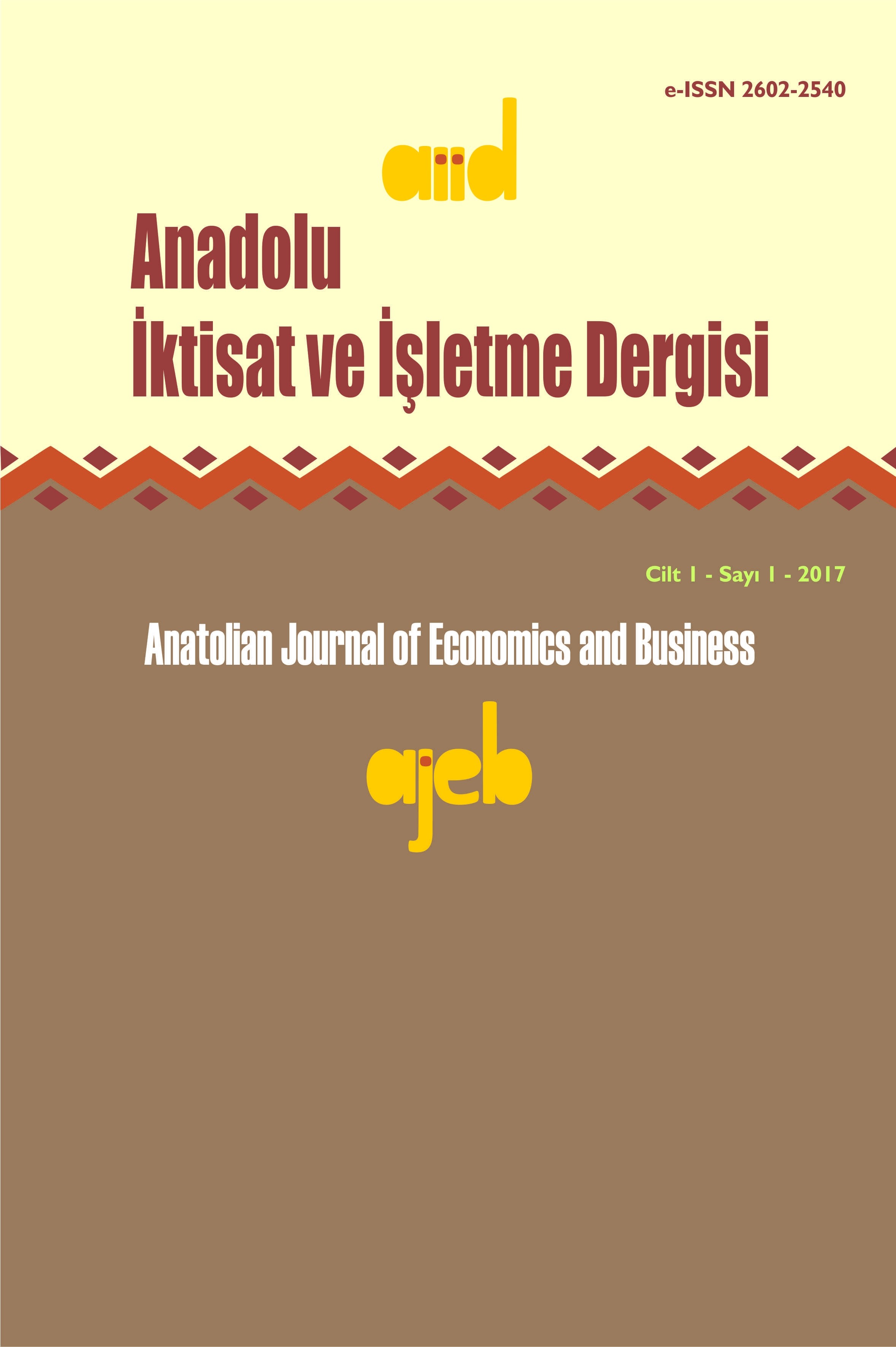Exchange Rate Pass-through into Import and Consumer Prices in Turkey
Bu çalışma, otoregresif dağıtılmış gecikme (ARDL) modelini uygulayarak son dönemlerde para birimi bir değer kaybı yaşayan ve ardından enflasyon oranındaki artışın buna eşlik ettiği Türkiye için döviz kurunun ithalat ve tüketici fiyatlarına geçişini ve bu geçişin asimetrik özelliklerini incelemektedir. Elde edilen sonuçlar, döviz kurunun ithalata ve tüketici fiyatlarına geçişini desteklemekte ve para politikasının ticaret açığıyla mücadeledeki etkinliğine işaret etmektedir. Ancak, enflasyon üzerinde birebir etkisi olduğu dikkate alındığında dış ticaret açığına yönelik döviz kuru kararlarında ihtiyatlı olmak gerekir. Bunun yanı sıra, döviz kurunun tüketici fiyatı üzerindeki etkisinin asimetrik olduğunu destekleyen kanıtlar elde edilmiştir. Liradaki değer kaybının tüketici fiyatları üzerindeki etkisinin değer kazanımlarının etkisinden daha fazla olduğu görülmüştür. Asimetrik analiz, ilgili dönemlerde Türk lirasının önemli değer kaybı göz önüne alındığında, önceki çalışmalara kıyasla döviz kur geçişkenliğindeki artışı açıklayabilir.
Anahtar Kelimeler:
Döviz kuru geçişi, ARDL, Fiyat
Exchange Rate Pass-Through into Import and Consumer Prices in Turkey
By applying the autoregressive distributed lag (ARDL) model, this study examines the exchange rate pass-through into import and consumer prices as well as its asymmetric framework for Turkey, which has experienced a recent currency depreciation and then an increase in the inflation rate. The results demonstrate the exchange rate pass-through into import and consumer prices are complete, which suggests the effectiveness of monetary policy to tackle trade deficit. However, the decision to use exchange rate to tackle trade deficit should be taken with caution as it has a one-to-one effect on inflation. Furthermore, the evidence for the asymmetric effect of exchange rate on consumer price is statistically significant. The depreciation of Turkish lira has more effect on consumer price than appreciation does. The asymmetric analysis may then explain the increase in exchange rate pass-through, compared to previous studies, given the significant depreciation of Turkish lira over the concerned periods.
Keywords:
Exchange rate pass-through, ARDL, Price,
___
- Akçelik F., Öğünç, F., 2016. Pass-through of crude oil prices at different stages in Turkey. Central Bank Review. Volume 16, Issue 1, March 2016, Pages 41-51
- Alper, K., 2003. “Exchange Rate Pass-Through to Domestic Prices in Turkish Economy,” Master’s Thesis. Ankara: Middle East Technical University.
- Arbatlı, Elif C., 2003. “Exchange Rate Pass-Through in Turkey: Looking for Asymmetries,” Central Bank Review, 2: 85-124.
- Ayşegül, D., 2009. Exchange rate pass-through in turkey: Asymmetric cointegration analysis. Master’s Thesis. Ankara: Bilkent University.
- Campa, J.M., Goldberg, L.S., 2005. Exchange rate pass-through into import prices. Rev. Econ. Stat. 87 (4), 679–690.
- Campa, J. M., Golberg, L., González-Mínguez, J. M., 2005. Exchange Rate Pass-Through to Import Prices in the Euro Area, NBER Working Paper No. 11632.
- Campa, J. M., González-mínguez, J. M., 2006. “Differences in Exchange Rate Pass-Through in the Euro Area”, European Economic Review, 50, pp. 121-145.
- CBRT (2019). Annual Report. Retrieved from http://www3.tcmb.gov.tr/yillikrapor/2019/en/m-0-4.html
- DE Bandt, Banerjee, O. A., Kozluk, T., 2007. Measuring Long-Run Exchange Rate Pass-Through, mimeo, European University Institute.
- Devereux, M., Yetman, J., 2002. "Price-Setting and Exchange Rate Pass-Through: Theory and Evidence, Price Adjustment, and Monetary Policy Conference." Bank of Canada, Ottawa (available at http://currencymuseum.ca/en/conference/Devereux_Yetman- v3
- Doğan, B.Ş., 2013. “Asymmetric Behavior of the Exchange Rate Pass-Through to Manufacturing Prices in Turkey.” Emerging Markets Finance and Trade 49, no. 3: 35–47.
- Engle, R., GRANGER, C., 1987. “Cointegration and error correction: representation, estimation and testing”, Econometrica, 55, pp. 251-276. Harris, R., Sollis, R., 2003. Applied Time Series Modelling and Forecasting. Wiley; West Sussex.
- Hooper, P., Mann, C.L., 1989. Exchange Rate Pass-Through in the 1980s: The Case of U.S. Imports of Manufactures. Brookings Papers on Economic Activity, Vol. 1989, No. 1, pp. 297-337
- Johansen, S., 1988. Statistical analysis of cointegration vectors. Journal of Economic Dynamics and Control Volume 12, Issues 2–3, June–September 1988, Pages 231-254
- Johansen, S., Juselius, K., 1990. Maximum Likelihood Estimation and Inference on Cointegration--With Applications to the Demand for Money. Oxford Bulletin of Economics and Statistics, 1990, vol. 52, issue 2, 169-210
- Kara, H., Öünç, F., 2005. “Exchange Rate Pass-Through in Turkey: Is it Slow, but is it Really Low?,” Central Bank of Turkey Research Department Working Paper No.05/10.
- Kotil, E., 2020. Exchange Rate Pass-Through Investigation for Turkish Economy. Front. Appl. Math. Stat. 5:66. doi: 10.3389/fams.2019.00066
- Kraft, E., 2003. "Monetary Policy Under Dollarization: The Case of Croatia." Comparative Economic Studies 45, no. 3: 256-277.
- Krugman, P., 1987. "Pricing to Market When the Exchange Rate Changes." In Financial Linkages Among Open Economies, ed. S. Arndt and J. Richardson, pp. 49-70. Cambridge, MA: MIT Press.
- Lee, J., 1997. The Response of Exchange Rate Pass-Through to Market Concentration in a Small Economy: The Evidence from Korea. The Review of Economics and Statistics, Vol. 79, No. 1 (Feb., 1997), pp. 142-145
- Maria-Dolores, R., 2008. “Exchange Rate Pass-Through in New Member States and Candidate Countries of the EU,” Bank of Spain Working Paper No.0822. (Check for the update by me)
- McCarthy, J., 2007. " Pass-Through of Exchange Rates and Import Prices to Domestic Inflation in Some Industrialized Economies." Eastern Economic Journal, Fall, 2007, Vol. 33, No. 4 (Fall, 2007), pp. 511-537
- Menon, J., 1996. The Degree and Determinants of Exchange Rate Pass-Through: Market Structure, Non-Tariff Barriers and Multinational Corporations. The Economic Journal, Vol. 106, No. 435 (Mar., 1996), pp. 434-444
- Pesaran, M. H., Shin, Y., Smith, R. J., 2001. Bounds testing approach to the analysis of level relationships. Journal of Applied Econometrics, Volume 16, pp. 289-326.
- Taylor, J. B., 2000. “Low Inflation, Pass-Through and the Pricing Power of Firms,” European Economic Review 44: 1389-1408.
- Webber, A., 1999. Dynamic and long run responses of import prices to the exchange rate in the Asia-pacific. Asian Econ. J. 13 (3), 303–320.
- Yanamandra, V., 2015. Exchange rate changes and inflation in India: What is the extent of exchange rate pass-through to imports? Economic Analysis and Policy 47 (2015) 57–68
- Yayın Aralığı: Yılda 2 Sayı
- Başlangıç: 2017
- Yayıncı: Seymur AĞAZADE
